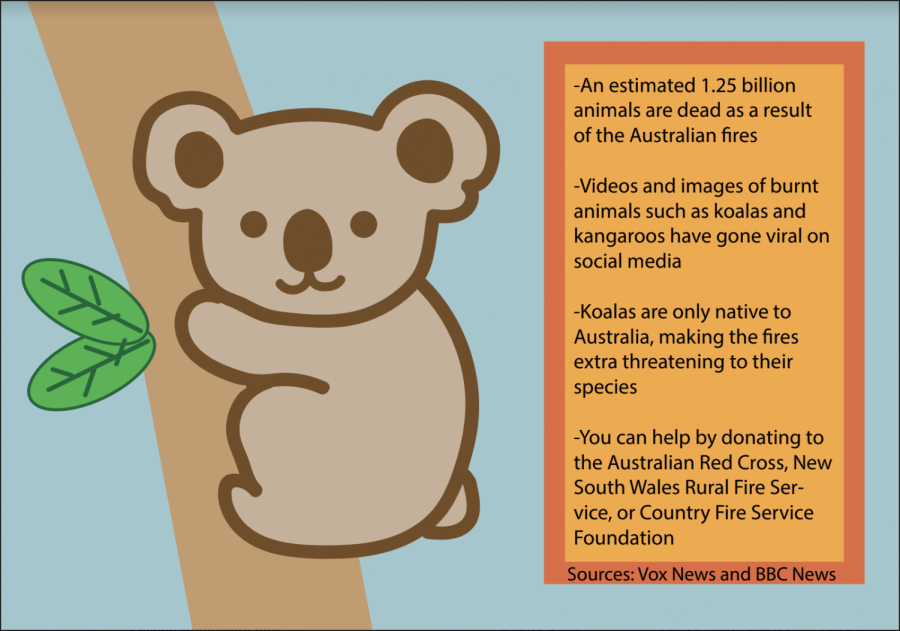The problem associated with the Australian fires
Australia is on fire. Over 18 and a half million acres have been burnt to ash-at least 30 people dead, with an inestimable destruction on animal habitats and unknown effect on the population of unique Australian wildlife.
February 17, 2020
Australia is on fire. Over 18 and a half million acres have been burnt to ash-at least 30 people dead, with inestimable destruction on animal habitats and unknown effects on the population of unique Australian wildlife. So much of Australia is engulfed in smoke, almost every smoke alarm is going off all around the continent.
Although influential politicians, such as Heather Miller, Richard Drax, and even Donald Trump have all claimed at least 70% of the cause for Australian fires are arsonists, the Australian Council of State Emergency Services (ACSES) and Australia’s National Centre for Research in Bushfire and Arson published a study in 2010 which determined only 13% of Australian wildfires are caused intentionally, and yet 85% of Australian fires overall are caused by human activity.
So how could the largest wildfire epidemic ever recorded be caused by a few arsonists? Although the Trump administration denies any correlation between climate change, there’s a clear problem with gas emission in Australia. A report by Greenpeace used satellite data from NASA to determine Australia’s gas plants released the worst sulfur dioxide (SO2) pollution around the globe, a dangerous gas that damages human health and contributes to the 3,000 Australian deaths resulting from air pollution.
Among the already mounting air problems, gas emission is another major source. In the Quarterly Update of Australia’s National Greenhouse Gas, national emissions increased by three million tons to hit 539 million tons. This is the highest ratio of emissions-to-population in the world.
Given that Australia is one of the hottest places on the planet, already susceptible to global warming, the high air pollutants increases concentrated smoke and rising heat in the continent. In the Climate Reality Project, they reported that Australia’s warmed over one degree since 1910. All these factors contributed greatly to the destruction of Australia. All the trapped gas and heating leads to an increased bushfire season and vulnerability to longer, harsher wildfires.
While most administrations are still denying any connection between global warming and Australia’s fires, it’s unlikely large gas companies located there aren’t to blame for this catastrophe.
Chevron donated one million dollars to the Australian wildfire efforts, but that’s not nearly enough to compensate for decades of reckless pollution, mining, and exploitation of Australia’s environment. Now, the consequences of exorbitant pollution are felt all across the country in the form of raging fires.
While there is currently little that can be done by civilians, other than being informed and donating to Australian charities, there are ways officials can prevent the unregulated and careless expansion of gas enterprises which makes global warming that much more prevalent. Rather than allow misinformation and greed to spread, leaders can hold accountable the billion-dollar corporations that profit from the reckless disregard of the environment in Australia, such as Chevron, Exxon, Shell, BP, Gazprom, Saudi Aramco, and major coal producers like Coal India and Peabody Energy.
Earth is the only planet where we can live, breathe, and consume. Whether we do so in a conservative, sustainable fashion or whether we do so with little thought of the effects our consumption has on the future is determined from the top down. The Australian bushfires are but one example of what happens when corporate and world leaders choose not to protect the Earth’s environments. No arson can do such harm overnight. The fires illustrate bad choices made over time on a grander scale by much bigger players who exploit natural resources to line their pockets.
As a result, our planet is on borrowed time, paying the price for decision-makers who are motivated by power and privilege. The lack of responsible business practices is the match that lights the fire and the lack of responsible leadership to hold them accountable is the gas that makes the fire grow. If we continue to enable such practices with thoughtless consumerism, the fires will never end. Even if the flames in Australia are extinguished, it is inevitably only a matter of time before another one starts somewhere else.









